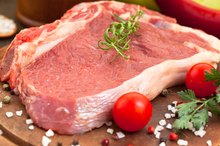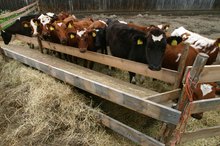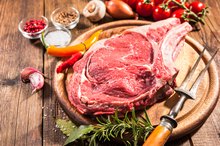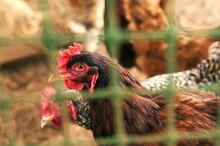Are Hormones in Meat Affecting Humans?
Eighty percent of U.S. cows are injected with hormones to increase their size, lean meat production and feed use efficacy. Although the European Union stopped buying U.S. meat in 1985 due to hormone use, the public opinion on its safety remains torn. U.S. cattle and sheep are fed, implanted or injected with hormones. Unless store-purchased meat is marked with USDA Organic Certified, there is a chance it contains residual hormones.
The Hormones
Part of the cattle hormone debate centers around the fact that three of the commonly used hormones are "all-natural." Estradiol, progesterone and testosterone are hormones found in humans in varying amounts. These hormones are responsible for regulating sexuality in males and females, as well as growth and the reproductive cycle. Trenbolone, zeranol and melengestrol acetate are chemical hormones that are man-made for cattle. The Food and Drug Administration stands by the fact that these hormones are not harmful in the amounts found in beef , although opposition states that studies were not comprehensive and more are needed to effectively conclude these hormones are safe 1.
- Part of the cattle hormone debate centers around the fact that three of the commonly used hormones are "all-natural."
- Trenbolone, zeranol and melengestrol acetate are chemical hormones that are man-made for cattle.
Affected Groups
Do Growth Hormones in Food Affect Children?
Learn More
Although the hormones are ingested by anyone who eats non-organic meats, there are a few populations who face a much higher health risk. Women who are pregnant and nursing, for instance, must weigh the benefits of a meal high in iron and protein vs. the scare of ingesting and feeding hormones from the meat to their unborn child. Opponents of hormone use suggest that young females enter puberty sooner due to ingesting hormones, which is verifiable by the decreasing age at which girls start their menses 3.
Hormone Content
The U.S. Food and Drug Administration regulates the amount of hormone that is safe to remain in the meat, called the MRL, or Maximum Residue Level 1. Animal organs, such as liver, are allowed higher MRLs than their muscle meat, such as steak. The FDA states that there is a zero-withdrawal period, meaning that the meat is safe for consumption at any time after the hormones are injected. These hormones may be inserted as pellets into the cattle's ear, injected or placed in their feed.
- The U.S. Food and Drug Administration regulates the amount of hormone that is safe to remain in the meat, called the MRL, or Maximum Residue Level 1.
Considerations
Does Meat Contain Estrogen?
Learn More
Early onset of puberty, increasing incidence of twin births and reproductive problems have all been blamed on the hormones in meat. Opponents to hormone use suggest that these growth hormones are linked to cancers, such as breast and uterine cancer, and developmental problems in children. The FDA denies that the microscopic amount of hormones in consumed meat can cause any health problems such as these. The bottom line remains buy organic if it is a concern. USDA Certified Organic meat cannot contain any artificial hormones, antibiotics or artificial chemicals.
- Early onset of puberty, increasing incidence of twin births and reproductive problems have all been blamed on the hormones in meat.
- The FDA denies that the microscopic amount of hormones in consumed meat can cause any health problems such as these.
Related Articles
References
Writer Bio
As a bachelor's-prepared registered nurse with more than 15 years of diversified experience, Juliet Wilkinson innerves our health-conscious population through expert articles. She is a motivated professional who believes that preventive care is the first step towards health and well-being.









